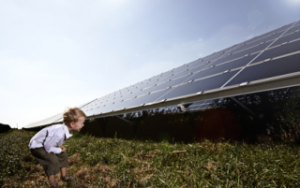Spreading energy democracy
 A group of environmentally-aware and civic-minded citizens gathered in the spring of 2013 in the village of Granville, in central Ohio. Their purpose was to explore the economic and ecological possibilities of solar power not just for themselves, but for the good of their community. As a result, they created the Licking County Solar Farm Co-op, LLC. The co-op is not only a source of solar energy for its members, but serves as a solar learning center as well.
A group of environmentally-aware and civic-minded citizens gathered in the spring of 2013 in the village of Granville, in central Ohio. Their purpose was to explore the economic and ecological possibilities of solar power not just for themselves, but for the good of their community. As a result, they created the Licking County Solar Farm Co-op, LLC. The co-op is not only a source of solar energy for its members, but serves as a solar learning center as well.
A co-op structure is not for everyone. According to the Solar Farm Co-op website, it’s a matter of first getting together with people who share your goals and values. Then, professional assistance must be sought to determine the project’s feasibility. Will a co-op really fulfill the group’s goals? What will be the benefits for the members (also known as “user-owners”)? What will their responsibilities be? How many members are needed for success, and how can more members be recruited?
The Solar Farm Co-op is a Limited Liability Corporation (LLC). (Every co-op is not necessarily an LLC; whether it ought to be depends upon the members’ needs.) Of the several possible models for a community solar project, an LLC belongs to the Special Purpose Entity (SPE) model, in which individual investors join together to develop the solar project. In an LLC, the members pool funds to cover the installation of a solar power array. The LLC furnishes the legal framework of the deal: the installation contract, the power purchase agreement with the host, insurance, maintenance provisions and the details of how income from the solar power system will get distributed.
The Granville co-op partnered with Joe and Larke Recchie of Community Renewable Energy, who agreed to host the co-op at their home. The host site manages and maintains the system, guaranteeing that it will itself be one of the customers of the system, and paying back the members on their investment based on the total amount of power produced. It also pays the utility for any excess energy consumed.
Community Renewable Energy on its website cites the US Department of Energy’s summary of the four advantages of community solar.
- Community solar overcomes barriers (it eliminates the difficulty of raising capital and allows access to federal tax credits);
- Community solar is inclusive (it allows many who ordinarily would not or could not purchase solar for themselves to participate, and allows them to be shareholders, rather than own a lease or license);
- Community solar is affordable (it ensures that the project will cost members the same or less than individual ownership, as well as providing a sound return on investment, and it disperses the benefits of solar power development, broadening participation and ownership); and
- Community solar is replicable (it serves as a model for other communities and challenges large energy users to reduce their carbon footprint).
Granville is the home of many educational institutions as well as local independent businesses, and the co-op hopes to partner eventually with some of these organizations. The co-op praises the Granville area as a leader in innovation and sustainability, and considers itself to be carrying on this tradition.
The co-op is setting out to educate people in the area about the advantages of community-owned solar, which is, in their words, “inclusive, allowing renters, students, businesses, nonprofits, and owners of shaded properties to support renewable energy, shrink their carbon footprints, and enjoy a return on their investment.” This description accords with what the Center for Social Inclusion (CSI) calls “energy democracy,” in which community members have a say in what kinds of energy they will use or create, and how they will employ it.
